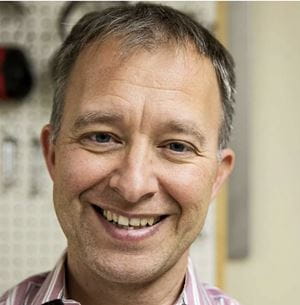A warm welcome to Dr. Kurokawa
LRI biomechanics engineer recognized for groundbreaking work

by Jonathan Nelson, Sr Writer, Legacy Public and Community Relations - April 2024
Not long ago, if you came to a Legacy hospital with severe injuries to your rib cage, the statistics were not in your favor. People with multiple fractured ribs would spend 15 to 30 days intubated. Their chance of infection was between 50% and 70%. Their mortality rate was anywhere from 15% to 39%, making it the highest of any orthopedic injury.
Michael Bottlang, PhD, and director for the biomechanics lab at the Legacy Research Institute, along with William Long, MD, and Steven Madey, MD, put those odds back into the patient’s favor when they designed a breakthrough rib plating technology.
The Chest Wall Injury Society is recognizing Michael’s work this month when it bestows upon him its highest honor, the Pioneer Award. Dr. Long, who also made history by revolutionizing emergency room trauma care at Legacy Emanuel Medical Center, will present the award to Michael.
"This award exemplifies the great potential for medical innovations when surgeons and engineering scientists collaborate," Michael said. "The Legacy Research Institute provided an ideal environment to foster this interdisciplinary collaboration."
Michael came to Legacy in 1999 after Dr. Madey recruited him from the University of Iowa. The pitch for the move was Dr. Madey's request that Michael start Legacy’s biomechanical research lab. "That was a bold move," Michael said.
In 2002, Michael teamed with Dr. Long, who has since retired, to solve a problem the trauma surgeon kept encountering from patients who came to Emanuel with severe chest injuries from car accidents or other trauma.
Michael’s anatomical research led him to define the characteristic surface shape of ribs to which plates need to be fixed, and to design rib plates with a low stiffness so it could expand and contract with a person’s breathing.
The Good Samaritan Foundation provided $23,000 to fund that initial work. In fact, Legacy’s foundations often provide Michael seed funding to help develop a prototype and confirm proof of concept, which then allows him to pitch his concepts to other funding sources. Legacy foundations have earmarked more than $3 million in fiscal year 2025 to various projects at the Legacy Research Institute.
By 2007, the engineer and physician had refined their plating technology. They licensed their rib plating system that year and they received approval from the U.S. Food and Drug Administration the following year. They held their first symposium for surgeons in 2009.
Dr. Long led the first course, teaching 30 surgeons how to use the chest plate system.
"A highlight of my career was one of the surgeons telling me it’s the most successful surgery he does," Michael said. The surgical procedure is now replicated around the world and the Chest Wall Injury Society grew from that work.
Today, Michael’s is focused on preventing brain injuries. The work is largely based on developing better helmets for construction workers. "Typically, when talking about brain injuries people think it’s about football," he said. "But they’re wrong. Construction workers are far more at jeopardy."
Michael’s work in this area has already made Legacy a recognized resource for helmet research and testing. "Legacy’s biomechanical research laboratory shows when you invest in research and create a collaboration between engineers and surgeons, you create a tremendous opportunity for change," Michael said.

